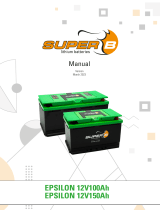
18
11. Warranty and liability
11.1 Upon delivery the customer is obliged to immediately verify whether the products have
been damaged during transport. In the event that any such damage has arisen, the customer
must notify Super B thereof as soon as possible, in any event no later than three (3) days of
delivery, by means of accurate, written statement, stating the damage and where possible a
photograph. Failure to inspect the products and inform Super B within the stated time or the
use of the products at any time shall be conclusive evidence that Super B has satisfactorily
tendered delivery.
11.2 In the event that the customer demonstrates that any of the delivered products do not
conform to the agreement, Super B (at its option, upon having received those products returned
by the customer) has the option to either repair or replace such products by new products, or to
refund the invoice value, exclusive of any dispatch costs.
11.3 Super B grants a three year limited warranty for damages caused by manufacturing
defects starting at the time of delivery. Damages caused by manufacturing defects do not
include damage resulting from (a) general wear and tear, (b) short circuit, (c) overcharging, (d)
deep discharging, (e) overheating of Super B products (f) installation of the Super B product by
persons unskilled to work with electro-technical devices or components, (g) any other wrongful
use contrary to the Super B’s user manual or the safety instruction, (h) any use contrary to the
product specications of that product; (i) any acts of force majeure.
11.4 The warranty period for parts of the product which have been repaired or replaced under
the warranty, shall be twelve (12) months from the date of repair or delivery of the replacement.
11.5 Except as specied in the clause 11.3 and 11.4 Super B makes no warranty, whether
express or implied, including without limitation any implied warranty of merchantability and
tness for a particular purpose or any warranty arising from any course of dealing, course of
performance or usage of trade and specically disclaims any representation or warranty that
the product will meet customer’s requirements, perform any specic function or achieve a
desired result other than expressly stated by Super B in writing.
11.6 Any liability to the customer in any case ceases to apply in the event that the customer
fails to notify Super B of the existence of the defect within ten (10) days of having discovered
the defect, in writing, in order to enable Super B to investigate the damage. Some of Super
B’s products electronically store usage data, including charging/discharging data, in order to
enable Super B to analyse such data retroactively when investigating damage.






















